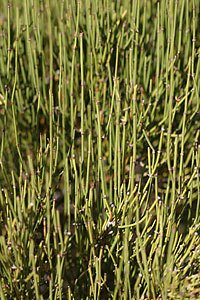Mormon Tea

Mormon Tea
Family: Gnetaceae Genus Ephedra Common names: Mormon Tea, Brigham Tea, Cowboy Tea, Whorehouse Tea, Squaw Tea, Canyon Tea Indian names: Tuttumpin (Paiute), Tutupivi (Kawaiisu) Distribution: All of the southwestern United States and Mexico. Found in deserts and on dry mountain sides. Description: a branched broomlike shrub growing up to 4 feet tall, with slender, jointed stems. The leaves are reduced to scales and grow in opposite pairs or whorls of three and are fused for half their length. Male and female flowers, blooming in March and April, are borne on separate plants in conelike structures. They are followed by small brown to black seeds.
Indians
The Indians prepared Ephedra as a tea for stomach and bowel disorders, for colds, fever, and headache. The dried and powdered twigs were used in poultices for burns and ointments for sores. One tribe made a decoction of the entire plant and drank it to help stop bleeding.
Pioneers

Early Mormon settlers, who abstained from regular tea and coffee, drank the beverage made from this plant. A handful of green or dry stems and leaves were placed in boiling water for each cup of tea desired. It was removed from the fire and allowed to steep for twenty minutes or more. To bring out the full flavor, a spoon of sugar or some strawberry jam was added depending on individual taste. Other white settlers used a very strong tea of the plant for the treatment of syphilis and other venereal disease, and as a tonic. It was standard fare in the waiting rooms of whorehouses in early Nevada and California. It was said to have been introduced by a Jack Mormon who frequented Katie’s Place in Elko, Nevada during the mining rush of the last century. Although not as potent as the commercial relatives in China and India, the southwestern species contains enough ephedrine-related alkaloid ingredients to make it functional. The drug ephedrine is a stimulant to the sympathetic nerves and has an effect on the body similar to adrenaline. It has a pronounced diuretic and decongestant effect and was used wherever urinary tract problems occurred.


0 Comments:
Post a Comment
<< Home